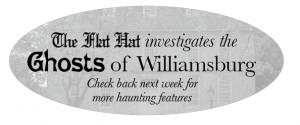Tour guides at the College of William and Mary say living in the President’s House comes with the perk of having “the world’s best commute.” What they don’t tell you is that the home also comes with one of the world’s scariest roommates.
Fortunately, current College President Taylor Reveley has yet to experience severe paranormal activity.
“It’s true. My wife and I do share the President’s House with the ghost of a French soldier who died there during the siege of Yorktown,” Reveley said in an email. “So far, he’s been quite well behaved. My wife says that a closet door on the second floor closes inexplicably every now and then. This is doubtless the French spirit’s doing as he roams the house at night. But the ghost and I have yet to cross paths. Very disappointing.”
The ghostly inhabitant of the President’s House was likely a young casualty of the Battle of Yorktown. During the fighting, the President’s House was purportedly converted into a hospital for wounded French soldiers. The third floor is said to have housed the direst cases.
“Past Presidents of the College claim to have heard unexplained footsteps in the night; they’ve told of slamming doors,” Original Ghosts of Williamsburg Candlelit Tour Guide Clare Britcher said. “During a building repair, a skeleton was found in the wall. Is it the frightened young boy who died on foreign soil still looking for a way home? Does he even know he is dead? All that is known is that the haunting appears to continue, and in fact, may never end.”
Perhaps the specter survived the fighting, only to perish in the flames that consumed the building shortly later— the fault of a few careless French officers occupying the structure.
Colonial Williamsburg Foundation Research Historian and Associate of the Omohundro Institute for Early American History and Culture Dr. Taylor Stoermer also speculated about the College’s haunted past, explaining that school-owned slaves originally constructed the President’s House. He also noted that the College has the most haunted campus in America, largely because of the harrowing history upon which it — and Williamsburg itself — has been built.
“[During the Revolutionary War], hundreds of soldiers did die in the Governor’s Palace and are buried behind it,” Stoermer said in an email. “Their presence — and their sacrifice — can still be felt. There was a young loyalist officer who had been a Harvard student and was buried in Williamsburg with full military honors by Lord Cornwallis, but his grave location was lost, so he is rumored to sometimes be seen looking for it.”
Stoermer enjoys a good ghost story, especially Washington Irving’s “The Legend of Sleepy Hollow,” but he does not believe in the concept of “ghosts as paranormal manifestations unexplained by scientific methods.” He most enjoys the legends built on concrete historical facts, viewing ghost stories as impressions left by people long gone.
“[Williamsburg is] certainly haunted by its rich past,” Stoermer said in an email. “Everywhere one turns, one is confronted by its fascinating history and the people who made it. Through each of those accounts we can help make the past more personal, and not so remote, even if it’s through a ghost story. In a sense, although it seems counterintuitive, ghost stories help bring the past alive when they’re based on real people who lived through — or didn’t live through — extraordinary times.”
The President’s House isn’t the only haunted building on campus. Read more about the College’s paranormal history here.





































